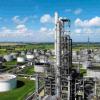Hello,
I would like to ask professionals if someone has correlations for outside film coefficients of Air-Cooled Heat Exchangers or can take a look on order of magnitude of values described below.
I faced with discrepancy between software results and plant data.
I found old paper with outside film coefficients diagrams in relation with surface ratio (Total/Bare), tube material, temperature of outside air and velocity of air in narrow cross section. After comparison it seems that calculated value (972 kcal/h-m2-C) is almost twice of diagram value (542 kcal/h-m2-C). Both values based on bare outside tube area.
The Air-Cooled heat exchanger has horizontal tubes and forced draught.
Surface ratio (Total/Bare)=20
Velocity of air in narrow cross section=4,7 m/s
Face velocity=3,2 m/s
Velocity of air in narrow cross section is defined as (coefficient which depends on type of unit * air volume flowrate of fan * coefficient accounting presence of louvers)/air density at average temperature.
Could you please share your opinion?
Thank you,
Nikolai
Edited by Nikolai T, 01 August 2019 - 08:27 PM.

 FB
FB













